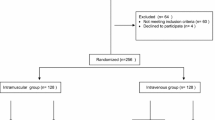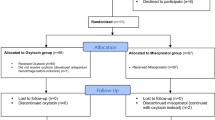Abstract
Background and Objectives
Postpartum hemorrhage is the single largest and leading cause of maternal morbidity and mortality not only in developing countries but also in developed countries. The present study is an attempt to evaluate the scope of using prophylactic intramuscular carboprost tromethamine 125 μg in comparison with intramuscular oxytocin 10 units for the active management of third stage of labor.
Materials and Methods
Two hundred pregnant women at term with spontaneous onset of labor were included in the study and were randomly divided into 2 groups of 100 women each. Group A and group B were given injection oxytocin 10 units and injection carboprost tromethamine 125 μg intramuscularly, respectively, at the time of delivery of anterior shoulder. The main outcome measures with respect to third stage of labor were: duration, blood loss by volume, difference in hemoglobin, need for additional oxytocics and side effects.
Results
Subjects who received carboprost tromethamine 125 μg showed a significant reduction in duration of third stage of labor (p < 0.05) and blood loss (p < 0.01) when compared to the subjects who received oxytocin 10 units. Likelihood of occurrence of postpartum hemorrhage was reduced without significant side effects except for diarrhea. Additional need for other uterotonics after carboprost was significantly less compared to oxytocin.
Conclusion
Intramuscular carboprost 125 μg is a better cost-effective alternative as compared to 10 units intramuscular oxytocin in active management of third stage of labor.



Similar content being viewed by others
References
Carroli G, Cuesta C, Abalos E, et al. Epidemiology of postpartum haemorrhage: a systematic review. Best Pract Res Clin Obstet Gynaecol. 2008;22:999–1012.
Shah D, Divakar H, Meghal T. Combating post partum hemorrhage in India: moving forward. In: Christopher B-L, Louis GK, Andre BL, Mahantesh K, editors. A Textbook of postpartum hemorrhage, a comprehensive guide to evaluate, management and surgical intervention. 1st ed. UK: Sapiens Publishing; 2006. p. 434–41.
Park K. Preventive medicine in obstetrics, pediatrics and geriatrics. In: Park K, editor. Textbook of preventive and social medicine. 22nd ed. Banasridas Bhanot: Jabalpur; 2013. p. 516–9.
Bhattacharya P, Devi PK, Jain S, et al. Prophylactic use of 15(S) 15 methyl PGF2 alpha by intramuscular route for control of postpartum bleeding—a comparative trial with methylergometrine. Acta Obstet Gynecol Scand. 1988;145 Suppl:S13–15.
Begley CM, Gyte GM, Devane D, et al. Active versus expectant management for women in the third stage of labour. Cochrane Database Syst Rev. 2011;11:CD007412.
Leduc D, Senikas V, Lalonde AB, et al. Active management of the third stage of labour: prevention and treatment of postpartum hemorrhage. J Obstet Gynaecol Can. 2009;31:980–93.
World Health Organization. WHO recommendations for the prevention of postpartum haemorrhage. Geneva: World Health Organisation, Department of Making Pregnancy Safer; 2007.
Chelmow D. Postpartum hemorrhage prevention: clinical evidence 2011: BMJ articles 2011 cited on 24/09/2013. www.pubmed.com.
Hofmeyr GJ, Gulmezoglu AM. New development in the management of postpartum hemorrhage. In: Bonner J, editor. Recent advances in obstetrics and gynaecology. 21st ed. London: Churchill Livingstone; 2000. p. 56–66.
International Confederation of Midwives, International Federation of Obstetrics and Gynecology. Prevention and treatment of post-partum hemorrhage. New advances for low resource settings. Int J Gynecol Obstet. 2007;97:160–3.
Gizzo S, Patrelli TS, Gangi SD, et al. Which uterotonic is better to prevent the postpartum hemorrhage? Latest news in terms of clinical efficacy, side effects, and contraindications: a systematic review. Reprod Sci. 2013;20:1011–9.
Roach MK, Abramovici A, Tita AT. Dose and duration of oxytocin to prevent postpartum hemorrhage: a review. Am J Perinatol. 2013;30(7):523–8.
Nordström L, Fogelstam K, Fridman G, et al. Routine oxytocin in the third stage of labor: a placebo controlled randomized trial. Br J Obstet Gynecol. 1997;104:781–6.
Kamalajayaram V, Devi ED. Prophylactic PGF2α for control of postpartum bleeding a comparative study with methyl ergometrine. J Obstet Gynaecol India. 1994;44:393–7.
Anjaneyulu R, Devi PK, Jain S, et al. Prophylactic use of 15 (5) methyl PGF2α by IM route- A controlled clinical trial. Acta Obstet Gynecol Scand Suppl. 1988;145:9–11.
Vaid A, Dadhwal V, Mittal S, et al. A randomized controlled trial of prophylactic sublingual misoprostol versus intramuscular methyl-ergometrine versus intramuscular 15-methyl PGF2alpha in active management of third stage of labor. Arch Gynecol Obstet. 2009;280:893–7.
Abdel-Aleem H, Abol Oyoun EM, Moustafa SA, et al. Carboprost trometamol in the management of the third stage of labor. Int J Gynaecol Obstet. 1993;42:247–50.
Bai J, Sun Q, Zhai H, et al. A comparison of oxytocin and carboprost in prevention of PPH in high risk patients in caesarean section. Exp Ther Med. 2014;7:46–50.
Buttino L Jr, Garite TJ. The use of 15 methyl F2 alpha prostaglandin (Prostin 15 M) for the control of postpartum hemorrhage. Am J Perinatol. 1986;3:241–3.
Author information
Authors and Affiliations
Corresponding author
Ethics declarations
Conflict of interest
All authors of the study declare that there is no conflict of interest of any type.
Ethical Statement
Permission was obtained from the ethical committee of the institution.
Additional information
Dr. K. S. Sunil Kumar is Professor and Unit Head, and Dr. Sundar Shyam is Assistant Professor in Department of OBGYN at SDM College of Medical Sciences and Hospital; Dr. Pavitra Batakurki is Consultant in Department of OBGYN at Ashirwada Hospital.
Rights and permissions
About this article
Cite this article
Sunil Kumar, K.S., Shyam, S. & Batakurki, P. Carboprost Versus Oxytocin for Active Management of Third Stage of Labor: A Prospective Randomized Control Study. J Obstet Gynecol India 66 (Suppl 1), 229–234 (2016). https://doi.org/10.1007/s13224-016-0842-x
Received:
Accepted:
Published:
Issue Date:
DOI: https://doi.org/10.1007/s13224-016-0842-x




